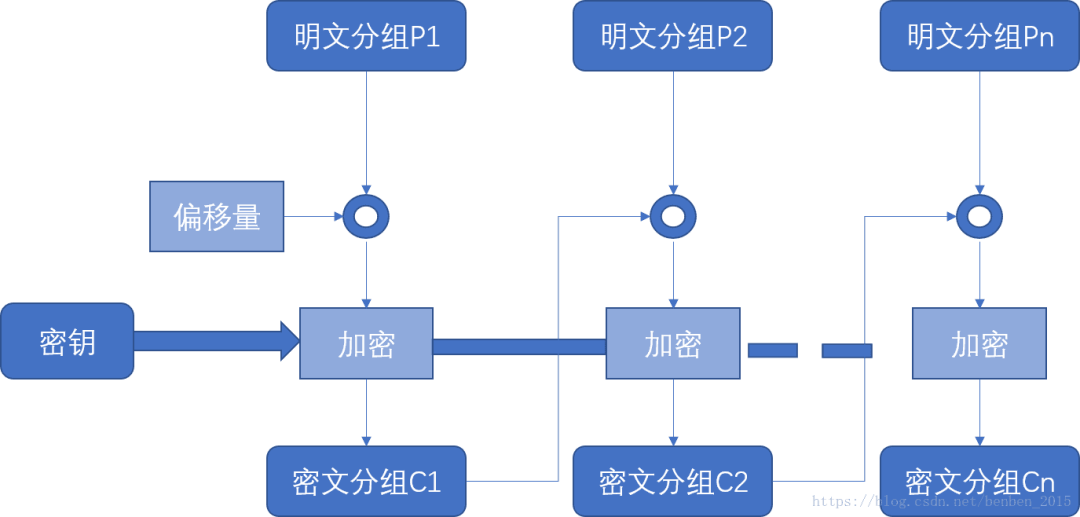Golang DES 加解密如何实现?
【导读】本文介绍了 DES 加密原理和作用,和 golang 中 DES 加密解密机制的相应实现。
概念理解
DES是以64比特的明文为一个单位来进行加密,并生成64比特的密文。由于它每次只能处理特定长度的一块数据,所以DES属于分组密码算法。cypto/des包提供了有关des加密的功能。
模式
ECB(electronic code book)是最简单的方式,它将明文分组加密后的结果直接成为密文分组。
优缺点:模式操作简单;明文中的重复内容将在密文中表现出来,特别对于图像数据和明文变化较少的数据;适于短报文的加密传递。
CBC(cipher block chaining)的原理是加密算法的输入是当前的明文分组和前一密文分组的异或,第一个明文分组和一个初始向量进行异或,这样同一个明文分组重复出现时会产生不同的密文分组。
特点:同一个明文分组重复出现时产生不同的密文分组;加密函数的输入是当前的明文分组和前一个密文分组的异或;每个明文分组的加密函数的输入与明文分组之间不再有固定的关系;适合加密长消息。
填充方式
密码
DES的密钥长度是64比特,但由于每隔7个比特会设置一个用于错误检测的比特,因此其实质密钥长度为56比特。
偏移量
输出
加密后的字节在显示时可以进行hex和base64编码,hex是十六进制编码,base64是一种基于64个可打印字符来标识二进制数据的方法。
下面以上面提到的几种模式和填充方式为例,进行演示如何在代码中使用。
加密模式采用ECB、填充方式采用pkcs5padding、密码使用"12345678",输出时经hex编码。自己可以通过一些在线测试工具进行测试,看结果是否一致。
package main
import (
"crypto/des"
"qiniupkg.com/x/errors.v7"
"bytes"
"fmt"
"encoding/hex"
)
func main() {
data:=[]byte("hello world")
key:=[]byte("12345678")
result,err:=DesECBEncrypt(data,key)
if err != nil {
fmt.Println(err)
}
a:=hex.EncodeToString(result)
fmt.Println(a)
}
func DesECBEncrypt(data, key []byte) ([]byte, error) {
//NewCipher创建一个新的加密块
block, err := des.NewCipher(key)
if err != nil {
return nil, err
}
bs := block.BlockSize()
data = Pkcs5Padding(data, bs)
if len(data)%bs != 0 {
return nil, errors.New("need a multiple of the blocksize")
}
out := make([]byte, len(data))
dst := out
for len(data) > 0 {
//Encrypt加密第一个块,将其结果保存到dst
block.Encrypt(dst, data[:bs])
data = data[bs:]
dst = dst[bs:]
}
return out, nil
}
func Pkcs5Padding(ciphertext []byte, blockSize int) []byte {
padding := blockSize - len(ciphertext)%blockSize
padtext := bytes.Repeat([]byte{byte(padding)}, padding)
return append(ciphertext, padtext...)
}
下面加密模式采用CBC、填充方式采用pkcs5padding、密码使用"12345678"、偏移量"43218765",输出时以hex方式输出。自己可以通过一些在线测试工具进行测试,看结果是否一致。
package main
import (
"crypto/des"
"bytes"
"fmt"
"encoding/hex"
"crypto/cipher"
)
func main() {
data := []byte("hello world")
key := []byte("12345678")
iv := []byte("43218765")
result, err := DesCBCEncrypt(data, key, iv)
if err != nil {
fmt.Println(err)
}
b := hex.EncodeToString(result)
fmt.Println(b)
}
func DesCBCEncrypt(data, key, iv []byte) ([]byte, error) {
block, err := des.NewCipher(key)
if err != nil {
return nil, err
}
data = pkcs5Padding(data, block.BlockSize())
cryptText := make([]byte, len(data))
blockMode := cipher.NewCBCEncrypter(block, iv)
blockMode.CryptBlocks(cryptText, data)
return cryptText, nil
}
func pkcs5Padding(cipherText []byte, blockSize int) []byte {
padding := blockSize - len(cipherText)%blockSize
padText := bytes.Repeat([]byte{byte(padding)}, padding)
return append(cipherText, padText...)
}
第三方包
github.com/marspere/goencrypt包实现了多种加密算法,包括对称加密和非对称加密等。
package main
import (
"fmt"
"github.com/marspere/goencrypt"
)
func main() {
// key为12345678
// iv为空
// 采用ECB分组模式
// 采用pkcs5padding填充模式
// 输出结果使用base64进行加密
cipher := goencrypt.NewDESCipher([]byte("12345678"), []byte(""), goencrypt.ECBMode, goencrypt.Pkcs5, goencrypt.PrintBase64)
cipherText, err := cipher.DESEncrypt([]byte("hello world"))
if err != nil {
fmt.Println(err)
return
}
fmt.Println(cipherText)
}
评论
